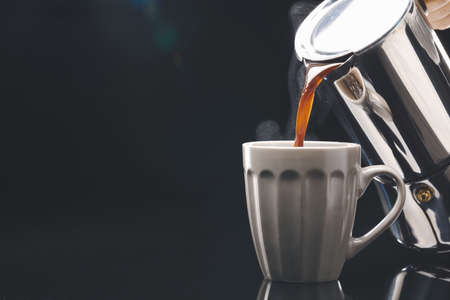Introduction to Pour Over Coffee in the UK
In recent years, the pour over coffee movement has steadily gained traction across the United Kingdom, captivating both dedicated enthusiasts and casual drinkers alike. Once largely dominated by traditional filter coffee and espresso-based beverages, British coffee culture is now embracing a new wave of brewing methods, with the V60 and Chemex leading the charge. The allure of pour over coffee lies in its ability to highlight nuanced flavour profiles, allowing drinkers to truly appreciate the distinct characteristics of single origin beans. This shift is evident not only in independent cafés across London, Manchester, Edinburgh and beyond, but also in homes where specialty coffee equipment is becoming a common sight. Local preferences continue to evolve as more Britons seek out lighter roasts and experiment with precision brewing techniques. As a result, pour over has established itself as both an accessible gateway for those new to specialty coffee and a meticulous craft for aficionados looking to refine their palate. This guide will explore everything you need to know about mastering V60 and Chemex brewing in the UK context, from sourcing beans to understanding water quality and perfecting your technique.
Choosing Your Equipment: V60 vs Chemex
When it comes to pour over coffee, the choice between the Hario V60 and Chemex is a central discussion for enthusiasts in the UK. Each brewer offers a unique experience, shaped by their technical design, environmental impact, and how well they fit into the British coffee lifestyle. Below, we compare these two icons across several key criteria relevant to UK homes and tastes.
Technical Differences
| Feature | Hario V60 | Chemex |
|---|---|---|
| Material Options | Ceramic, glass, plastic, metal | Borosilicate glass with wooden or glass collar |
| Filter Type | Thin, ribbed paper filters | Thick, bonded paper filters |
| Shape & Flow Rate | Conical with spiral ridges; faster flow rate | Hourglass; slower extraction due to thicker filter |
| Brew Sizes | 1-4 cups typically | 3-10 cups (larger sizes available) |
Suitability for UK Homes
The compact size of the V60 makes it ideal for urban flats or kitchens where space is at a premium—a common scenario in cities like London or Manchester. Its versatility means you can brew directly into your mug or a server, perfect for solo drinkers or couples. Conversely, the Chemex stands out for hosting: its larger capacity and elegant design make it a centrepiece for gatherings, afternoon teas, or sharing during a Sunday brunch. However, its fragility and size may not suit every British kitchen.
Sustainability Considerations
Sustainability is increasingly important to UK consumers. Both devices are long-lasting with minimal waste; however, the Chemex uses thicker filters that require more paper per brew. The V60’s thinner filters are often compostable and widely available across Britain’s specialty shops. If you favour reusable solutions, stainless steel and cloth alternatives exist for both brewers—though purists argue these subtly alter flavour profiles.
Chemex vs V60 Sustainability Table
| Criteria | Chemex | V60 |
|---|---|---|
| Filter Compostability | Yes (but more material) | Yes (less material) |
| Lifespan of Brewer | Long (if handled carefully) | Long (more robust options available) |
Reflecting British Coffee Trends
The past decade has seen Britain’s coffee culture shift towards lighter roasts and nuanced flavours—favouring clarity over heaviness. The V60, with its fast drainage and control over extraction variables, appeals to those seeking vibrant acidity and transparency—key characteristics celebrated in contemporary British cafés from Edinburgh to Bristol. Meanwhile, the Chemex’s thicker filter tends to mute acidity but delivers a clean cup with heavier body—a nod to those who enjoy balance and subtlety with their morning papers. Both brewers are embraced by the UK’s thriving specialty scene, reflecting a national penchant for experimentation as well as tradition.

3. Selecting the Right Coffee Beans
Choosing the perfect beans is a crucial step in crafting exceptional pour over coffee, whether you prefer the clarity of a V60 or the elegance of a Chemex. In the UK, where discerning palates and a deep appreciation for traceability are on the rise, sourcing high-quality beans has become an art form in itself.
Sourcing Beans from UK-Based Roasters
British coffee culture is thriving, thanks to a vibrant community of local roasters dedicated to quality and sustainability. Notable names such as Workshop Coffee, Square Mile, and North Star Roastery have set benchmarks by carefully curating green beans from origin and roasting them to highlight unique flavour profiles. When selecting beans for pour over methods, it’s wise to seek out specialty roasters who offer full transparency—look for details like farm name, varietal, altitude, and processing method right on the bag. This level of traceability not only ensures ethical sourcing but also empowers you to tailor your choice according to your taste preferences.
Taste Profiles Favoured by British Enthusiasts
The British palate often leans towards nuanced and balanced coffees rather than overpowering intensity. For pour over brewing, light to medium roasts are generally preferred; they preserve delicate floral notes, bright acidity, and subtle sweetness—qualities that shine through both the V60 and Chemex. East African origins such as Ethiopian or Kenyan beans are especially popular for their vibrant fruitiness and tea-like body. However, Central American coffees with hints of caramel or citrus also find favour among UK drinkers seeking a rounded cup that pairs perfectly with a slice of Victoria sponge or an afternoon biscuit.
Key Considerations for Pour Over Selection
- Freshness: Always opt for beans roasted within the past two weeks for optimal aroma and flavour clarity.
- Grind Size: Invest in a burr grinder to achieve a consistent medium-fine grind—the ideal texture for even extraction in pour over methods.
- Single Origin vs Blend: Single origin coffees allow you to explore terroir-driven nuances, while blends can provide balance and complexity that suits British tastes.
Final Thoughts
The journey towards mastering pour over coffee in the UK begins with thoughtful bean selection. By supporting reputable UK-based roasters, prioritising traceability, and choosing taste profiles that suit your preferences, you lay the foundation for truly remarkable brews at home—whether enjoyed solo or shared as part of Britain’s cherished coffee ritual.
4. The Brewing Process: Techniques and Tips
Mastering the art of pour over coffee with the V60 and Chemex requires attention to technique, understanding your local water profile, and an appreciation for detail. Below youll find step-by-step instructions tailored for both brewers, designed to help you extract the best flavours from your beans—be they single origin or blends curated for British tastes.
Step-by-Step Brewing Instructions
V60 Pour Over Method
- Preparation: Place a V60 filter in the dripper and rinse thoroughly with hot water. Discard the rinse water.
- Grind Size: Use a medium-fine grind, similar to granulated sugar. This suits most UK-roasted beans and balances extraction well.
- Coffee Dose: Measure 15g of coffee per 250ml of water (adjust to taste).
- Water Temperature: Heat filtered water to 92–96°C; this is ideal for UK tap water profiles.
- The Bloom: Start by pouring just enough water (about twice the weight of coffee) to saturate the grounds. Let it bloom for 30–45 seconds to release CO2.
- Pours: Pour the remaining water in slow, controlled circles, avoiding the edges. Aim for a total brew time of 2:30–3:00 minutes.
Chemex Pour Over Method
- Preparation: Insert a Chemex filter and rinse it with hot water. Discard the rinse water.
- Grind Size: Choose a coarser grind, akin to sea salt, as Chemex filters are thicker and require more flow.
- Coffee Dose: Use 30g of coffee per 500ml of water (scalable as needed).
- Water Temperature: Maintain between 92–96°C, mindful of your local water chemistry.
- The Bloom: Saturate the grounds with about 60ml of water; allow 40–45 seconds for blooming.
- Pours: Add the rest of the water in stages, using a spiral motion. Aim for a total brew time of 4–5 minutes for clarity and body.
Essential Variables: Grind, Water Chemistry, and Pouring Style
| Variable | V60 | Chemex |
|---|---|---|
| Grind Size | Medium-fine | Coarse |
| Brew Time | 2:30–3:00 min | 4–5 min |
| Coffee-to-Water Ratio | 1:16–1:17 | 1:16–1:17 |
Water Chemistry: Hard vs Soft Water in the UK
The UKs tap water varies significantly by region—London and much of southern England experience hard water, while Scotland and parts of Wales have softer profiles. Hard water can mute acidity and produce muddier cups, whereas soft water tends to highlight brightness but may lack body. For best results, use filtered or bottled water with moderate mineral content (around 75–150 ppm total dissolved solids), ensuring clarity and balance in your cup.
Pouring Style Tips
- A gooseneck kettle offers superior control—essential for even extraction on both V60 and Chemex.
- Avoid aggressive pours that disturb the bed or cause channeling; opt for gentle spirals starting from the centre outward.
Tuning these variables allows you to adapt your pour over method to both your local water conditions and personal flavour preferences—a true hallmark of British home brewing mastery.
5. Common Mistakes and How to Avoid Them
Even the most enthusiastic home baristas across the UK can fall into a few common traps when preparing pour over coffee with the V60 or Chemex. Here’s a practical analysis of frequent errors observed in British kitchens, alongside actionable advice tailored to our climate and consumer habits.
Incorrect Grind Size and Its Impact
One of the most prevalent mistakes is using an inappropriate grind size. Too fine, and your brew turns out bitter and over-extracted; too coarse, and it becomes weak and underwhelming. For both V60 and Chemex, opt for a medium grind—resembling granulated sugar for V60, and slightly coarser for Chemex. If you’re sourcing beans from your local roaster or supermarket, ask them to grind specifically for your chosen method. Investing in a quality burr grinder can also make all the difference.
Water Temperature: The British Kettle Conundrum
The quintessential British kettle is a staple, but many overlook the significance of water temperature. Pouring boiling water directly onto the coffee scorches delicate aromatics, while cooler water leads to flatness in flavour. Aim for water just off the boil—around 92–96°C. Some electric kettles offer temperature control; otherwise, let your boiled water sit for 30 seconds before pouring.
Poor Quality or Incorrectly Filtered Water
The mineral content of tap water varies greatly across the UK, often leading to inconsistency in extraction. Hard water areas (like London) may mute flavours, while soft water (common in Scotland) can cause over-acidity. Use filtered water to reduce chlorine and unwanted minerals, or consider bottled spring water if you’re chasing perfection in every cup.
Neglecting Bloom Time
Rushing the brewing process by skipping or shortening the bloom phase—when hot water first meets ground coffee—can trap carbon dioxide and hinder extraction. Always pour enough water to saturate the grounds (about twice their weight), then wait 30–45 seconds before proceeding. This simple step unlocks more nuanced flavours.
Incorrect Pouring Technique
A hurried or uneven pour can lead to channeling, where water finds paths of least resistance through the coffee bed, resulting in uneven extraction. For both V60 and Chemex, use slow, circular motions starting at the centre and working outward. Consider using a gooseneck kettle for greater control—a worthwhile investment for consistent results.
Overlooking Local Roasts
While it’s tempting to stick with supermarket brands, exploring beans from local UK roasters can dramatically elevate your brew. Many offer single-origin selections roasted specifically with pour over methods in mind—supporting both your palate and local businesses.
Adapting to the UK Climate
The cool, damp British climate may affect how quickly your coffee cools post-brew. To avoid lukewarm cups, preheat your carafe and mug with hot water before brewing—a simple touch that preserves temperature without compromising taste.
By addressing these common pitfalls with a bit of technical know-how and some home-grown sensibility, you’ll be well on your way to mastering pour over coffee with either V60 or Chemex—right here in Blighty.
6. Enhancing Your Pour Over Experience
Elevating Your Coffee Routine
Once youve mastered the fundamentals of pour over brewing with V60 or Chemex, its time to refine your daily ritual and truly savour each cup. The journey doesn’t end at technique; rather, the next step is about adding personal touches and embracing the unique flavours that can be drawn from British coffee culture.
Pairing Recommendations: Classic British Treats
To fully enjoy your pour over coffee, consider pairing it with quintessential British treats. A freshly brewed V60 pairs beautifully with a slice of Victoria sponge cake, where the lightness of the cake complements the clarity of the brew. For a richer experience, match a Chemex brew with buttery shortbread or a warm scone topped with clotted cream and strawberry jam. These classic pairings not only enhance the tasting notes of your coffee but also infuse your routine with comfort and tradition.
Coffee Storage Tips for UK Conditions
The UKs variable climate can affect coffee freshness, so proper storage is key. Always keep your beans in an airtight container, away from moisture and sunlight—ideally in a cool cupboard rather than the fridge or freezer. If possible, buy whole beans in small batches from your local roaster and grind just before brewing to preserve those delicate aromas intrinsic to a quality pour over.
Supporting Local UK Coffee Communities
Choosing to source your beans from UK-based specialty roasters not only guarantees freshness but also supports local businesses and sustainable practices. Many independent British roasteries offer unique single-origin coffees that showcase both global diversity and local expertise. By engaging with these communities—whether through attending tastings, following them on social media, or subscribing to a coffee delivery—you become part of a thriving movement that values traceability, ethical sourcing, and exceptional craftsmanship.
Final Thoughts: Building Your Own British Coffee Ritual
Enhancing your pour over experience is about more than just technique; its about creating moments of enjoyment rooted in quality and connection. By thoughtfully pairing your brew with beloved British treats, storing your coffee properly, and supporting local artisans, you elevate every cup—making each sip a celebration of both craft and culture.


